Input interpretation

NH_4Cl ammonium chloride + Ba(NO_3)_2 barium nitrate ⟶ NH_4NO_3 ammonium nitrate + BaCl_2 barium chloride
Balanced equation
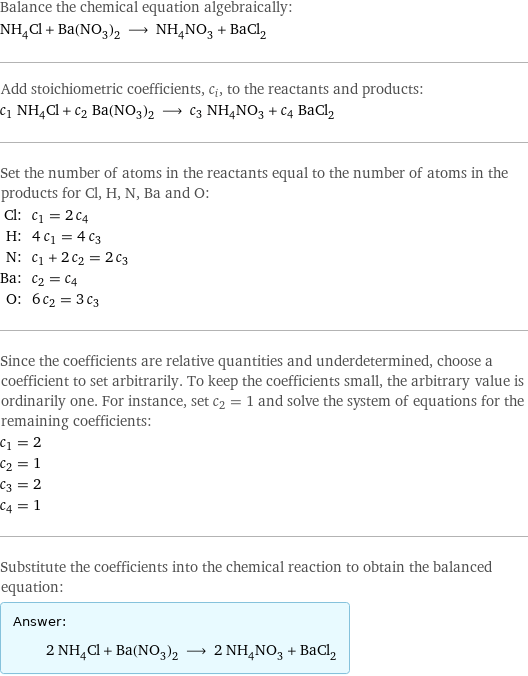
Balance the chemical equation algebraically: NH_4Cl + Ba(NO_3)_2 ⟶ NH_4NO_3 + BaCl_2 Add stoichiometric coefficients, c_i, to the reactants and products: c_1 NH_4Cl + c_2 Ba(NO_3)_2 ⟶ c_3 NH_4NO_3 + c_4 BaCl_2 Set the number of atoms in the reactants equal to the number of atoms in the products for Cl, H, N, Ba and O: Cl: | c_1 = 2 c_4 H: | 4 c_1 = 4 c_3 N: | c_1 + 2 c_2 = 2 c_3 Ba: | c_2 = c_4 O: | 6 c_2 = 3 c_3 Since the coefficients are relative quantities and underdetermined, choose a coefficient to set arbitrarily. To keep the coefficients small, the arbitrary value is ordinarily one. For instance, set c_2 = 1 and solve the system of equations for the remaining coefficients: c_1 = 2 c_2 = 1 c_3 = 2 c_4 = 1 Substitute the coefficients into the chemical reaction to obtain the balanced equation: Answer: | | 2 NH_4Cl + Ba(NO_3)_2 ⟶ 2 NH_4NO_3 + BaCl_2
Structures
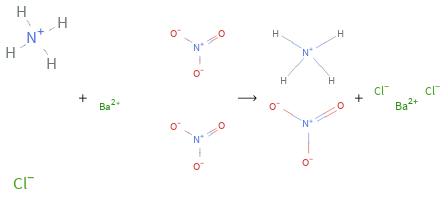
+ ⟶ +
Names

ammonium chloride + barium nitrate ⟶ ammonium nitrate + barium chloride
Reaction thermodynamics
Gibbs free energy
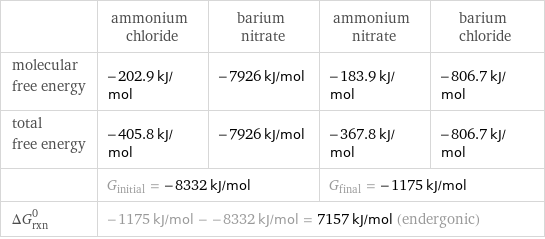
| ammonium chloride | barium nitrate | ammonium nitrate | barium chloride molecular free energy | -202.9 kJ/mol | -7926 kJ/mol | -183.9 kJ/mol | -806.7 kJ/mol total free energy | -405.8 kJ/mol | -7926 kJ/mol | -367.8 kJ/mol | -806.7 kJ/mol | G_initial = -8332 kJ/mol | | G_final = -1175 kJ/mol | ΔG_rxn^0 | -1175 kJ/mol - -8332 kJ/mol = 7157 kJ/mol (endergonic) | | |
Equilibrium constant
![Construct the equilibrium constant, K, expression for: NH_4Cl + Ba(NO_3)_2 ⟶ NH_4NO_3 + BaCl_2 Plan: • Balance the chemical equation. • Determine the stoichiometric numbers. • Assemble the activity expression for each chemical species. • Use the activity expressions to build the equilibrium constant expression. Write the balanced chemical equation: 2 NH_4Cl + Ba(NO_3)_2 ⟶ 2 NH_4NO_3 + BaCl_2 Assign stoichiometric numbers, ν_i, using the stoichiometric coefficients, c_i, from the balanced chemical equation in the following manner: ν_i = -c_i for reactants and ν_i = c_i for products: chemical species | c_i | ν_i NH_4Cl | 2 | -2 Ba(NO_3)_2 | 1 | -1 NH_4NO_3 | 2 | 2 BaCl_2 | 1 | 1 Assemble the activity expressions accounting for the state of matter and ν_i: chemical species | c_i | ν_i | activity expression NH_4Cl | 2 | -2 | ([NH4Cl])^(-2) Ba(NO_3)_2 | 1 | -1 | ([Ba(NO3)2])^(-1) NH_4NO_3 | 2 | 2 | ([NH4NO3])^2 BaCl_2 | 1 | 1 | [BaCl2] The equilibrium constant symbol in the concentration basis is: K_c Mulitply the activity expressions to arrive at the K_c expression: Answer: | | K_c = ([NH4Cl])^(-2) ([Ba(NO3)2])^(-1) ([NH4NO3])^2 [BaCl2] = (([NH4NO3])^2 [BaCl2])/(([NH4Cl])^2 [Ba(NO3)2])](../image_source/72e6dd57410a4df7e2876a6782201d86.png)
Construct the equilibrium constant, K, expression for: NH_4Cl + Ba(NO_3)_2 ⟶ NH_4NO_3 + BaCl_2 Plan: • Balance the chemical equation. • Determine the stoichiometric numbers. • Assemble the activity expression for each chemical species. • Use the activity expressions to build the equilibrium constant expression. Write the balanced chemical equation: 2 NH_4Cl + Ba(NO_3)_2 ⟶ 2 NH_4NO_3 + BaCl_2 Assign stoichiometric numbers, ν_i, using the stoichiometric coefficients, c_i, from the balanced chemical equation in the following manner: ν_i = -c_i for reactants and ν_i = c_i for products: chemical species | c_i | ν_i NH_4Cl | 2 | -2 Ba(NO_3)_2 | 1 | -1 NH_4NO_3 | 2 | 2 BaCl_2 | 1 | 1 Assemble the activity expressions accounting for the state of matter and ν_i: chemical species | c_i | ν_i | activity expression NH_4Cl | 2 | -2 | ([NH4Cl])^(-2) Ba(NO_3)_2 | 1 | -1 | ([Ba(NO3)2])^(-1) NH_4NO_3 | 2 | 2 | ([NH4NO3])^2 BaCl_2 | 1 | 1 | [BaCl2] The equilibrium constant symbol in the concentration basis is: K_c Mulitply the activity expressions to arrive at the K_c expression: Answer: | | K_c = ([NH4Cl])^(-2) ([Ba(NO3)2])^(-1) ([NH4NO3])^2 [BaCl2] = (([NH4NO3])^2 [BaCl2])/(([NH4Cl])^2 [Ba(NO3)2])
Rate of reaction
![Construct the rate of reaction expression for: NH_4Cl + Ba(NO_3)_2 ⟶ NH_4NO_3 + BaCl_2 Plan: • Balance the chemical equation. • Determine the stoichiometric numbers. • Assemble the rate term for each chemical species. • Write the rate of reaction expression. Write the balanced chemical equation: 2 NH_4Cl + Ba(NO_3)_2 ⟶ 2 NH_4NO_3 + BaCl_2 Assign stoichiometric numbers, ν_i, using the stoichiometric coefficients, c_i, from the balanced chemical equation in the following manner: ν_i = -c_i for reactants and ν_i = c_i for products: chemical species | c_i | ν_i NH_4Cl | 2 | -2 Ba(NO_3)_2 | 1 | -1 NH_4NO_3 | 2 | 2 BaCl_2 | 1 | 1 The rate term for each chemical species, B_i, is 1/ν_i(Δ[B_i])/(Δt) where [B_i] is the amount concentration and t is time: chemical species | c_i | ν_i | rate term NH_4Cl | 2 | -2 | -1/2 (Δ[NH4Cl])/(Δt) Ba(NO_3)_2 | 1 | -1 | -(Δ[Ba(NO3)2])/(Δt) NH_4NO_3 | 2 | 2 | 1/2 (Δ[NH4NO3])/(Δt) BaCl_2 | 1 | 1 | (Δ[BaCl2])/(Δt) (for infinitesimal rate of change, replace Δ with d) Set the rate terms equal to each other to arrive at the rate expression: Answer: | | rate = -1/2 (Δ[NH4Cl])/(Δt) = -(Δ[Ba(NO3)2])/(Δt) = 1/2 (Δ[NH4NO3])/(Δt) = (Δ[BaCl2])/(Δt) (assuming constant volume and no accumulation of intermediates or side products)](../image_source/55bf9da30a1fb9b89dadcebc34d0ae74.png)
Construct the rate of reaction expression for: NH_4Cl + Ba(NO_3)_2 ⟶ NH_4NO_3 + BaCl_2 Plan: • Balance the chemical equation. • Determine the stoichiometric numbers. • Assemble the rate term for each chemical species. • Write the rate of reaction expression. Write the balanced chemical equation: 2 NH_4Cl + Ba(NO_3)_2 ⟶ 2 NH_4NO_3 + BaCl_2 Assign stoichiometric numbers, ν_i, using the stoichiometric coefficients, c_i, from the balanced chemical equation in the following manner: ν_i = -c_i for reactants and ν_i = c_i for products: chemical species | c_i | ν_i NH_4Cl | 2 | -2 Ba(NO_3)_2 | 1 | -1 NH_4NO_3 | 2 | 2 BaCl_2 | 1 | 1 The rate term for each chemical species, B_i, is 1/ν_i(Δ[B_i])/(Δt) where [B_i] is the amount concentration and t is time: chemical species | c_i | ν_i | rate term NH_4Cl | 2 | -2 | -1/2 (Δ[NH4Cl])/(Δt) Ba(NO_3)_2 | 1 | -1 | -(Δ[Ba(NO3)2])/(Δt) NH_4NO_3 | 2 | 2 | 1/2 (Δ[NH4NO3])/(Δt) BaCl_2 | 1 | 1 | (Δ[BaCl2])/(Δt) (for infinitesimal rate of change, replace Δ with d) Set the rate terms equal to each other to arrive at the rate expression: Answer: | | rate = -1/2 (Δ[NH4Cl])/(Δt) = -(Δ[Ba(NO3)2])/(Δt) = 1/2 (Δ[NH4NO3])/(Δt) = (Δ[BaCl2])/(Δt) (assuming constant volume and no accumulation of intermediates or side products)
Chemical names and formulas
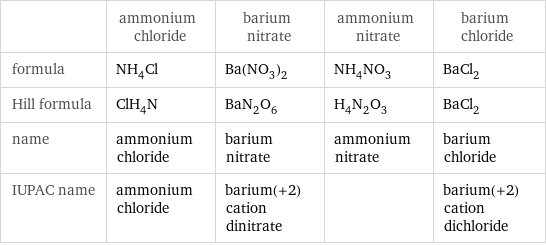
| ammonium chloride | barium nitrate | ammonium nitrate | barium chloride formula | NH_4Cl | Ba(NO_3)_2 | NH_4NO_3 | BaCl_2 Hill formula | ClH_4N | BaN_2O_6 | H_4N_2O_3 | BaCl_2 name | ammonium chloride | barium nitrate | ammonium nitrate | barium chloride IUPAC name | ammonium chloride | barium(+2) cation dinitrate | | barium(+2) cation dichloride
Substance properties
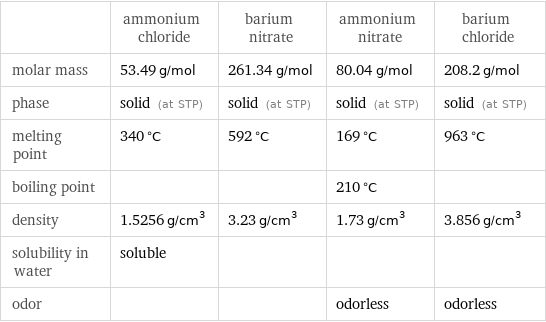
| ammonium chloride | barium nitrate | ammonium nitrate | barium chloride molar mass | 53.49 g/mol | 261.34 g/mol | 80.04 g/mol | 208.2 g/mol phase | solid (at STP) | solid (at STP) | solid (at STP) | solid (at STP) melting point | 340 °C | 592 °C | 169 °C | 963 °C boiling point | | | 210 °C | density | 1.5256 g/cm^3 | 3.23 g/cm^3 | 1.73 g/cm^3 | 3.856 g/cm^3 solubility in water | soluble | | | odor | | | odorless | odorless
Units
